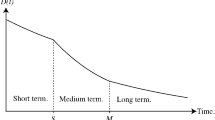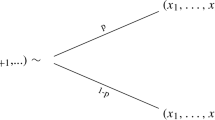Abstract
This paper formulates and axiomatizes utility models for denumerable time streams that make no commitment in regard to discounting future outcomes. The models address decision under certainty and decision under risk. Independence assumptions in both contexts lead to additive or multiplicative utilities over time periods that allow unambiguous comparisons of the relative importance of different periods. The models accommodate all patterns of future valuation. This discount-neutral feature is attained by restricting preference comparisons to outcome streams or probability distributions on outcome streams that differ in at most a finite number of periods.
Similar content being viewed by others
REFERENCES
Algoet, P.H.: 1994, ‘The strong law of large numbers for sequential decisions under uncertainty’, IEEE Transactions on Information Theory 40, 609–633.
Bailey, S.: 1825, A Critical Dissertation on the Nature, Measure, and Causes of Value, New York: Augustus M. Kelly (1967).
Balintfy, J.L., Duffy, W.J. and Sinha, P.: 1974, ‘Modeling food preferences over time’, Operations Research 22, 711–727.
Baumol, W.J.: 1958, ‘On the social rate of discount’, American Economic Review 58, 788–802.
Becker, R.A., Boyd, J.H. and Sung, B.Y.: 1989, ‘Recursive utility and optimal capital accumulation. I. Existence’, Journal of Economic Theory 47, 76–100.
Bernoulli, D.: 1738, ‘Specimen theoriae novae de mensura sortis’, Commentarii Academiae Scientiarum Imperialis Petropolitanae 5, 175–192. Translated by L. Sommer: 1954, ‘Exposition of a new theory on the measurement of risk’, Econometrica 22, 23–36.
Blackwell, D.: 1965, ‘Discounted dynamic programming’, Annals of Mathematical Statistics 36, 226–235.
Blackwell, D. and Girshick, M.A.: 1954, Theory of Games and Statistical Decisions, New York: Wiley.
Bleichrodt, H. and Gafni, A.: 1994, ‘Time preference, the discounted utility model and health’, preprint.
Böhm-Bawerk, E. von: 1889, Positive Theorie des Kapitals, Vol. II, 4th edn., translated by I.D. Huncke: 1959, Capital and Interest, Vol. II, Positive Theory of Capital, Book IV, Section I, pp. 257–289, South Holland, IL: Libertarian Press.
Brown, D.J. and Lewis, L.M.: 1981, ‘Myopic economic agents’, Econometrica 49, 359–368.
Chow, Y.S. and Robbins, H.: 1963, ‘On optimal stopping rules’, Zeitschrift für Wahrscheinlichkeitstheorie und verwandte Gebiete 2, 33–49.
Cowen, T. and High J.: 1988, ‘Time, bounded utility, and the St. Petersburg paradox’, Theory and Decision 25, 219–223.
Dana, R.A. and Le Van, C.: 1991, ‘Equilibria of a stationary economy with recursive preferences’, Journal of Optimization Theory and Applications 71, 289–313.
Debreu, G.: 1960, ‘Topological methods in cardinal utility theory’, in Mathematical Methods in the Social Sciences, 1959, K.J. Arrow, S. Karlin and P. Suppes, (ed.) pp. 16–26, Stanford: Stanford University Press.
Diamond, P.A.: 1965, ‘The evaluation of infinite utilitystreams’, Econometrica 33, 170–177.
Duffie, D., Epstein, L.G. and Skiadas, C.: 1992, ‘Stochastic differential utility’, Econometrica 60, 353–394.
Epstein, L.G. and Wang, T.: 1994, ‘Intertemporal asset pricing under Knightian uncertainty’, Econometrica 62, 283–322.
Epstein, L. and Zin, S.: 1989, ‘Substitution, risk aversion and the temporal behavior of consumption and asset returns: A theoretical framework’, Econometrica 57, 937–969.
Fetter, F.A.: 1915, Economic Principles, Vol. I, New York: The Century Co.
Fetter, F.A.: 1977, Capital, Interest, and Rent: Essays in the Theory of Distribution, ed. by M. Rothbard, Kansas City: Sheed Andrews and McMeel.
Fishburn, P.C.: 1965a, ‘Independence in utility theory with whole product sets’, Operations Research 13, 28–45.
Fishburn, P.C.: 1965b, ‘Markovian dependence in utility theory with whole product sets’, Operations Research 13, 238–257.
Fishburn, P.C.: 1966, ‘Additivity in utility theory with denumerable product sets’, Econometrica 34, 500–503.
Fishburn, P.C.: 1970, Utility Theory for Decision Making, New York: Wiley.
Fishburn, P.C.: 1990, ‘Continuous nontransitive additive conjoint measurement’, Mathematical Social Sciences 20, 165–193.
Fisher, I.: 1892, ‘Mathematical investigations in the theory of values and prices’, Transactions of the Connecticut Academy of Arts and Sciences 9, 1–124.
Fisher, I.: 1930, The Theory of Interest, New York: Macmillan.
Gilboa, I.: 1989, ‘Expectation and variation in multi-period decisions’, Econometrica 57, 1153–1169.
Gordon, B.: 1975, Economic Analysis Before Adam Smith: Hesiod to Lessius, New York: Barnes and Noble.
Hammond, P.J.: 1976, ‘Changing tastes and coherent dynamic choice’, Review of Economic Studies 43, 159–173.
Harvey, C.M.: 1988, ‘Utility functions for infinite-period planning’, Management Science 34, 645–665.
Harvey, C.M.: 1994, ‘The reasonableness of non-constant discounting’, Journal of Public Economics 53, 31–51.
Harvey, C.M.: 1995, ‘Proportional discounting of future costs and benefits’, Mathematics of Operations Research 20, 381–399.
Jensen, N.E.: 1967, ‘An introduction to Bernoullian utility theorem. I. Utility functions’, Swedish Journal of Economics 69, 163–183.
Kauder, E.: 1965, A History of Marginal Utility Theory, Princeton: Princeton University Press.
Keeney, R.L.: 1968, ‘Quasi-separable utility functions’, Naval Research Logistics Quarterly 15, 551–565.
Keeney, R.L. and Raiffa, H.: 1976, Decisions with Multiple Objectives: Preferences and Value Tradeoffs, New York: Wiley.
Kohn, M.G. and Shavell, S.: 1974, ‘The theory of search’, Journal of Economic Theory 9, 93–123.
Koopmans, T.C.: 1960, ‘Stationary ordinal utility and impatience’, Econometrica 28, 287–309.
Koopmans, T.C.: 1972, ‘Representation of preference orderings over time’, in Decision and Organization, ed. by C.B. McGuire and R. Radner, pp. 79–100, Amsterdam: North-Holland.
Krantz, D.H., Luce, R.D., Suppes, P. and Tversky, A.: 1971, Foundations of Measurement, Vol. I, New York: Academic Press.
Kreps, D.M. and Porteus, E.L.: 1977, ‘On the optimality of structured policies in countable stage decision processes. II: Positive and negative problems’, SIAM Journal on Applied Mathematics 32, 457–466.
Kreps, D.M. and Porteus, E.L.: 1978, ‘Temporal resolution of uncertainty and dynamic choice theory’, Econometrica 46, 185–200.
Kreps, D.M. and Porteus, E.L.: 1979, ‘Dynamic choice theory and dynamic programming’, Econometrica 47, 91–100.
Loewenstein, G.: 1987, ‘Anticipation and the valuation of delayed consumption’, Economic Journal 97, 666–684.
Loewenstein, G. and Elster, J.: 1992, Choice over Time, New York: Russell Sage Foundation.
Loewenstein, G. and Prelec, D.: 1991, ‘Negative time preference’, AEA Papers and Proceedings 81, 347–352.
Loewenstein, G. and Thaler, R.: 1989, ‘Anomalies: Intertemporal choice’, Journal of Economic Perspectives 3, 181–193.
Lucas, R. and Stokey, N.: 1984, ‘Optimal growth with many consumers’, Journal of Economic Theory 32, 139–171.
Menger, K.: 1934, ‘Das Unsicherheitsmoment in der Wertlehre’, Zeitschrift für Nationaloekonomie 5, 459–485. Translated by W. Schoellkopf: 1967, ‘The role of uncertainty in economics’, in Essays in Mathematical Economics, ed. M. Shubik, pp. 211–231, Princeton: Princeton University Press.
Nairay, A.: 1984, ‘Asymptotic behavior and optimal properties of a consumptioninvestment model with variable time preference’, Journal of Economics and Dynamic Control 7, 283–313.
Olson, M. and Bailey, M.J.: 1981, ‘Positive time preference’, Journal of Political Economy 89, 1–25.
Pauly, M.V.: 1970, ‘Risk and the social rate of discount’, American Economic Review 60, 195–198.
Peleg, B. and Yaari, M.E.: 1973, ‘On the existence of a consistent course of action when tastes are changing’, Review of Economic Studies 40, 391–401.
Pollak, R.A.: 1967, ‘Additive von Neumann-Morgenstern utility functions’, Econometrica 35, 485–494.
Ramsey, F.P.: 1928, ‘A mathematical theory of saving’, Economic Journal 38, 543–559.
Rothbard, M.N.: 1990, ‘Time preference’, in The New Palgrave: Utility and Probability, ed. by J. Eatwell, M. Milgate and P. Newman, pp. 270–275, London: Macmillan.
Samuelson, P.A.: 1977, ‘St. Petersburg paradoxes: Defanged, dissected, and historically described’, Journal of Economic Literature 15, 24–55.
Savage, L.J.: 1954, The Foundations of Statistics, New York: Wiley.
Shafer, G.: 1988, ‘The St. Petersburg paradox’, in Encyclopedia of Statistical Sciences, Vol. 8, ed. by S. Kotz and N.L. Johnson, pp. 865–870, New York: Wiley.
Streufert, P.A.: 1993, ‘Abstract recursive utility’, Journal of Mathematical Analysis and Applications 175, 169–185.
Suppes, P. and Zinnes, J.L.: 1963, ‘Basic measurement theory’, in Handbook of Mathematical Psychology, I, ed. by R.D. Luce, R.R. Bush, and E. Galanter, New York: Wiley.
Toulet, C.: 1986, ‘An axiomatic model of unbounded utility functions’, Mathematics of Operations Research 11, 81–94.
Uzawa, H.: 1968, ‘Time preference, the consumption function, and optimum asset holdings’, in Value, Capital and Growth: Papers in Honour of Sir John Hicks, ed. by J.N. Wolfe, Edinburgh: Edinburgh University Press.
von Mises, L.: 1949, Human Action: A Treatise on Economics, third revised edn. (1966), Chicago: Regnery.
Wakker, P.P.: 1989, Additive Representations of Preferences, Dordrecht: Kluwer Academic.
Wakker, P.P.: 1993, ‘Unbounded utility for Savage's ‘Foundations of Statistics’ and other models’, Mathematics of Operations Research 18, 446–485.
Weibull, J.W.: 1985, ‘Discounted-value representationsof temporal preferences’, Mathematics of Operations Research 10, 244–250.
Yahav, J.A.: 1966, ‘On optimal stopping’, Annals of Mathematical Statistics 37, 30–35.
Author information
Authors and Affiliations
Rights and permissions
About this article
Cite this article
Fishburn, P., Edwards, W. Discount-neutral utility models for denumerable time streams. Theory and Decision 43, 139–166 (1997). https://doi.org/10.1023/A:1004943925179
Issue Date:
DOI: https://doi.org/10.1023/A:1004943925179




